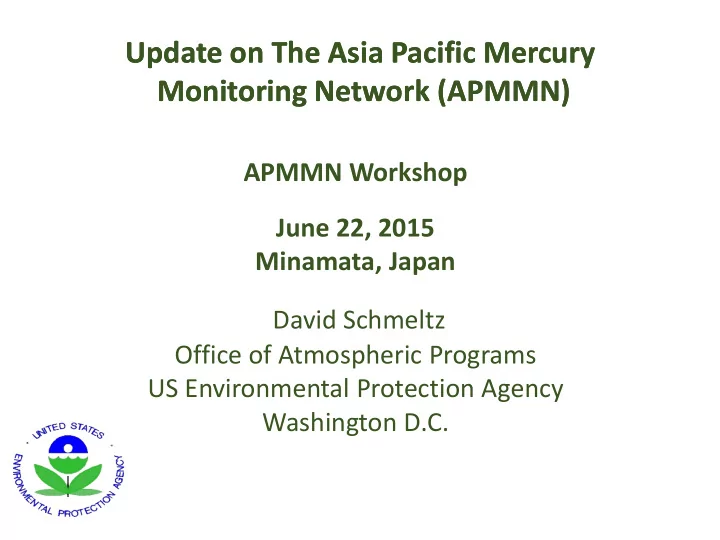

Update on The Asia Pacific Mercury Update on The Asia Pacific Mercury Monitoring Network (APMMN) Monitoring Network (APMMN) APMMN Workshop June 22, 2015 Minamata, Japan David Schmeltz Office of Atmospheric Programs US Environmental Protection Agency Washington D.C.
A Comprehensive and Integrated Multimedia Monitoring Network is Needed Initial focus on mercury in rainwater and air − Primary input to ecosystems Not very costly (wet) Anybody can do it Lots of experience doing it − Many experts regionally/globally NCON Model NADP-style Japanese-style Taiwan-style MDN 00-125-2 Aerochem 301 MIC Example Wet Deposition Samplers
Motivation Minamata Convention expected into force soon − Provisions for monitoring and effectiveness evaluation Few long-term measurements in region Many scientific papers published; but limited data available Accurate and comparable data needed for modeling and assessments Opportunities − Improve regional monitoring coordination − Assist countries with limited monitoring experience (build capacity)
Atmospheric Mercury Monitoring Workshop, 2012 in Taipei l Scientific participation from Canada, Indonesia, Japan, Korea, Taiwan, Thailand, and the U.S. l Exchanged information on programs in North America and Asia that monitor mercury and related atmospheric pollutants l Identified key monitoring gaps in the region l Articulated a need for a coordinated Asia-wide network to monitor mercury transport and deposition
Mercury Monitoring Workshop, 2013 in Washington, D.C. l Shared latest information from each partner agency − VEA, EPA, NADP, EPAT, NCU, Environment Canada, Thai land ERTC, Japan MOE & NIMD, Korea NIER, Indonesia MOEF l Agreement on major design elements of an operating pilot network for the region l Established a science advisory group l Devised a preliminary plan for deploying wet deposition collectors in Southeast Asia
Asia Pacific Mercury Monitoring Network (APMMN) Workshop, 2014 in Hanoi l Training − Wet deposition operations − Atmospheric mercury analysis using NIMD and MOEJ methods − Automated system for monitoring gaseous and particulate mercury l Completion of SOPs for wet deposition l APMMN Pilot sites in Thailand, Vietnam, and Indonesia proposed
The Asia-Pacific Mercury Monitoring Network (APMMN) is… A group of countries, agencies, academics and monitoring groups Making measurements of ₋ Mercury in wet deposition ₋ Concentrations of mercury in gaseous and particle bound forms Using the same instruments and standard operating procedures across Asian countries and consistent with U.S. operations Sharing data to solve the mercury problem
Recap of APMMN Progress 2012-2014 Wet Deposition Sites Participation from: Korea, Japan, Taiwan Thailand, Indonesia, Philippines, Vietnam, Canada, U.S., Hong Kong Established a Science Advisory Group Launched a 3-year pilot network for mercury wet deposition; initial sites in Thailand and Vietnam; Indonesia and Philippines coming soon… ₋ Developed SOP based on NADP/MDN ₋ Sample collection started Fall 2014 Samples shipped to National Central University, Taiwan for total Hg analysis U.S. led capacity building and operator training workshops Operating Sites Website: apmmn.org.tw Affiliated Sites Pending Sites Laboratory
APMMN Next Steps Near-term Wet Deposition Sites Expand regional monitoring coverage ⁻ Wet deposition samplers for 20 - 30 additional monitoring stations (blue) Develop robust database and populate with observations Network the existing atmospheric monitoring stations Continue to provide training on monitoring methods Longer-term Expand APMMN laboratory capacity Launch inter-laboratory quality assurance study among established mercury labs in the region (Korea, Japan, and Taiwan run their own) Work with partners on proposals to fund the long- term operation of APMMN sites Operating Sites Planned Sites Affiliated Sites Pending Sites Laboratory
Logo Discussion
Recommend
More recommend